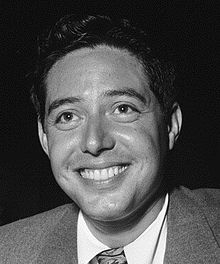Andy Russell (singer)
| Andy Russell | |
|---|---|

Russell in 1947
|
|
| Born |
Andrés Rábago September 16, 1919 Boyle Heights, Los Angeles, California, U.S. |
| Died | April 16, 1992 (aged 72) Sun City, Arizona, U.S. |
| Cause of death | Stroke |
| Nationality | American |
| Other names | Andrew El diente que canta (The Teeth that Sing) El mago de los sueños (The Dream Wizard) |
| Occupation |
Vocalist Percussionist Radio host Radio actor and singer Television singer Motion picture actor and singer Television variety show host Nightclub singer |
| Years active | 1934–1989 |
| Spouse(s) | Evelyn Marie Morse (1940-1945) Della Russell (1945-1954) Velia Sánchez Belmont (1954-?) Virginia "Ginny" Pace (1967-1987) Doris E. Russell (?-1992, his death) |
| Musical career | |
| Genres | Traditional pop, Latin music, Big band, Swing, Easy listening |
| Instruments | Vocals, Drums |
| Labels | Capitol, RCA Victor, Orfeon, Belter/Divusca |
| Associated acts |
Gus Arnheim Orchestra Al Sack Orchestra Paul Weston Orchestra Vido Musso Orchestra Alvino Rey Orchestra The King Sisters The Pied Pipers Della Russell Emily Cranz |
Andy Russell (born Andrés Rábago; September 16, 1919 – April 16, 1992) was an American popular vocalist, actor, and entertainer of Mexican descent, specializing in traditional pop and Latin music. He sold 8 million records in the 1940s singing in a romantic, baritone voice and in his trademark bilingual English and Spanish style. He had chart-busters, such as "Bésame Mucho," "Amor," and "What a Diff'rence a Day Made." He also made personal appearances and performed on radio programs, most notably Your Hit Parade, in several movies, and on television. During this initial phase of his career, his popularity in the United States rivaled that of crooners Frank Sinatra and Perry Como.
In 1954, he relocated to Mexico where he became the star of radio, television, motion pictures, records, and nightclubs. He also toured extensively throughout Latin America, Spain, Portugal, and Cuba, and was the host of the television variety program El Show de Andy Russell in Argentina from 1956 to 1965, now achieving international success during this second phase of his career.
...
Wikipedia
